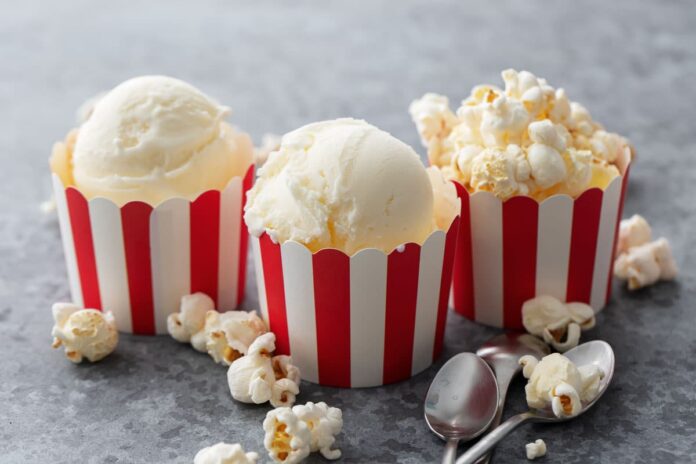Sweet, salty, buttery, and fabulous, this unique ice cream flavor will have you craving more! Made with an eggless ice cream base steeped with real buttered popcorn, then churned into a dreamy, ultra-creamy ice cream that’ll satisfy sweet and salty snackers alike!
Imagine the flavor of freshly popped popcorn drizzled in melted butter and generously sprinkled with sea salt. And then imagine that flavor transformed into a sweet, salty, and ultra creamy homemade ice cream. It might sound like strange magic—and, to be fair, the way the cream absorbs so much of the popcorn flavor kinda is—this frozen mashup needs to go on your to-make list this summer!
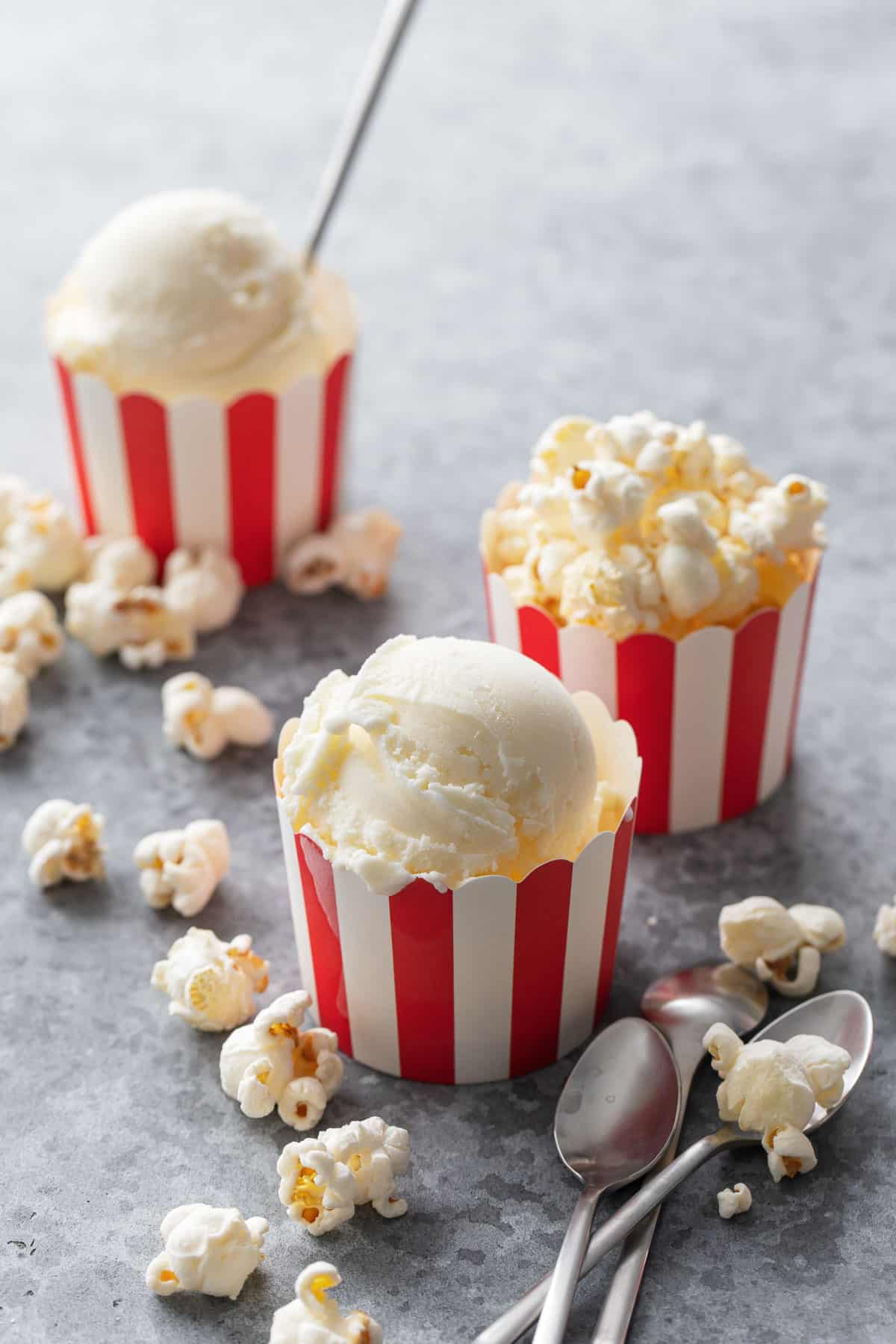
A few years ago Jeni’s had a limited edition ice cream flavor called Sun-Popped Corn.
It was a pint-sized miracle. Truly. And I know you’re skeptical right now, considering the horror that is the popcorn jelly bean (seriously, who thinks that tastes good?) but trust me when I say that Jeni’s magical popcorn ice cream tasted nothing like that artificially flavored abomination.
I’ve been wishing and hoping it’d come back for years, always checking the seasonal flavors when summer rolls around, but I’ve yet to see it again (there is a caramel popcorn flavor this summer, but it’s not quite the same).
So, rather than pining for this elusive flavor for yet another summer, I decided I’d make my own instead.
And let me tell you, it turned out way better than I ever could have imagined.
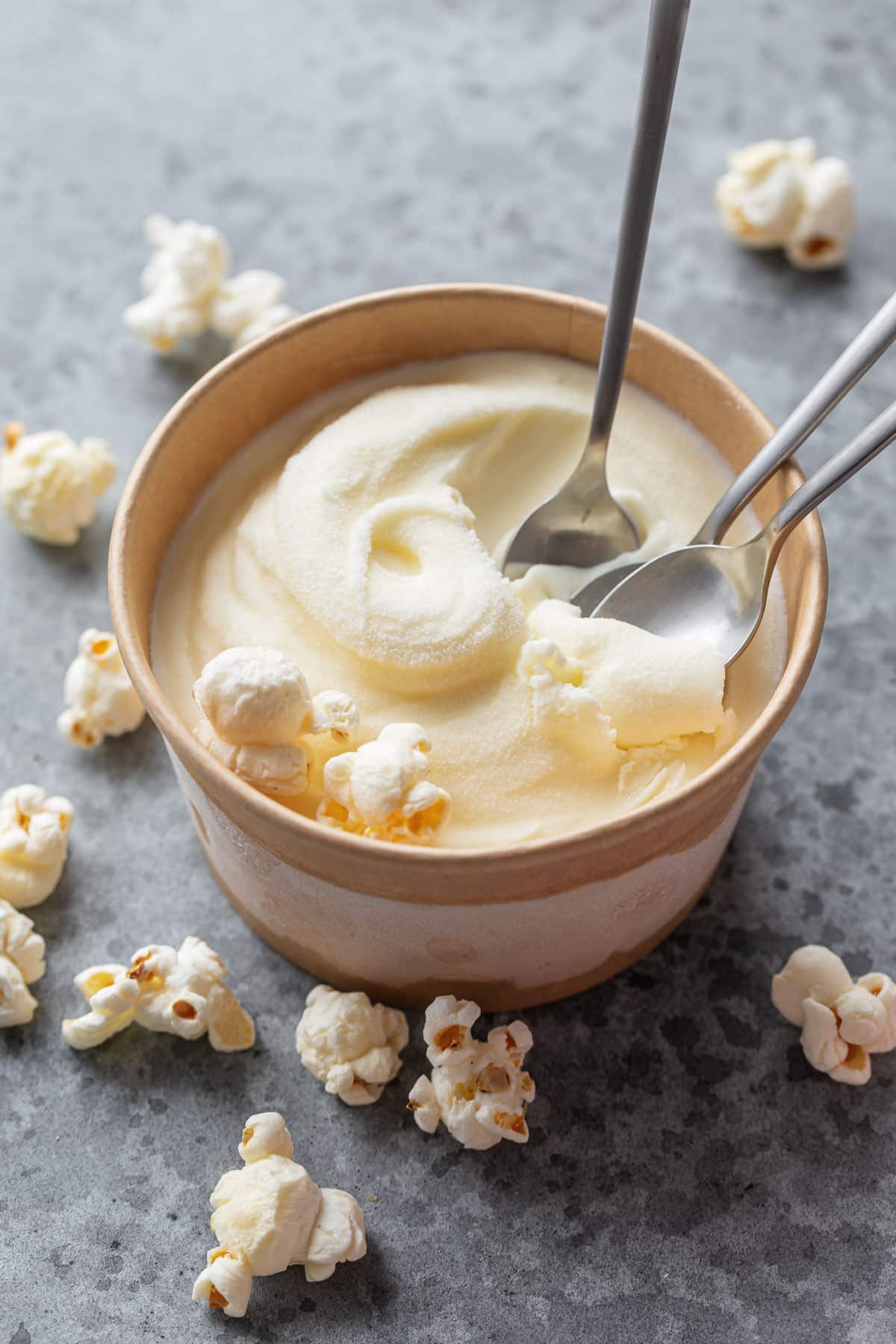

Similar to my sourdough ice cream and toasted brioche and jam ice cream, which both infused the flavor of bread into the dairy base, this recipe does the same thing… but with popcorn. It’s quite extraordinary, really, just how much popcorn flavor transfers into the cream. I remember the sourdough ice cream surprising me much in the same way, so I probably should have expected that popcorn would work just as well.
The result is a creamy, dairy-forward ice cream that tastes like frozen popcorn, with notes of sweet corn, grass-fed butter, and a punch of sea salt for that perfect sweet-and-salty combo.
As we were eagerly scarfing the results of my first test batch, Taylor revealed that he used to love to snack on microwave popcorn dipped in milk. Which is basically this ice cream at room temperature. So it’s no wonder he was a huge fan of this unusual flavor (but really, is it just me or is that a really weird snack for a kid?)
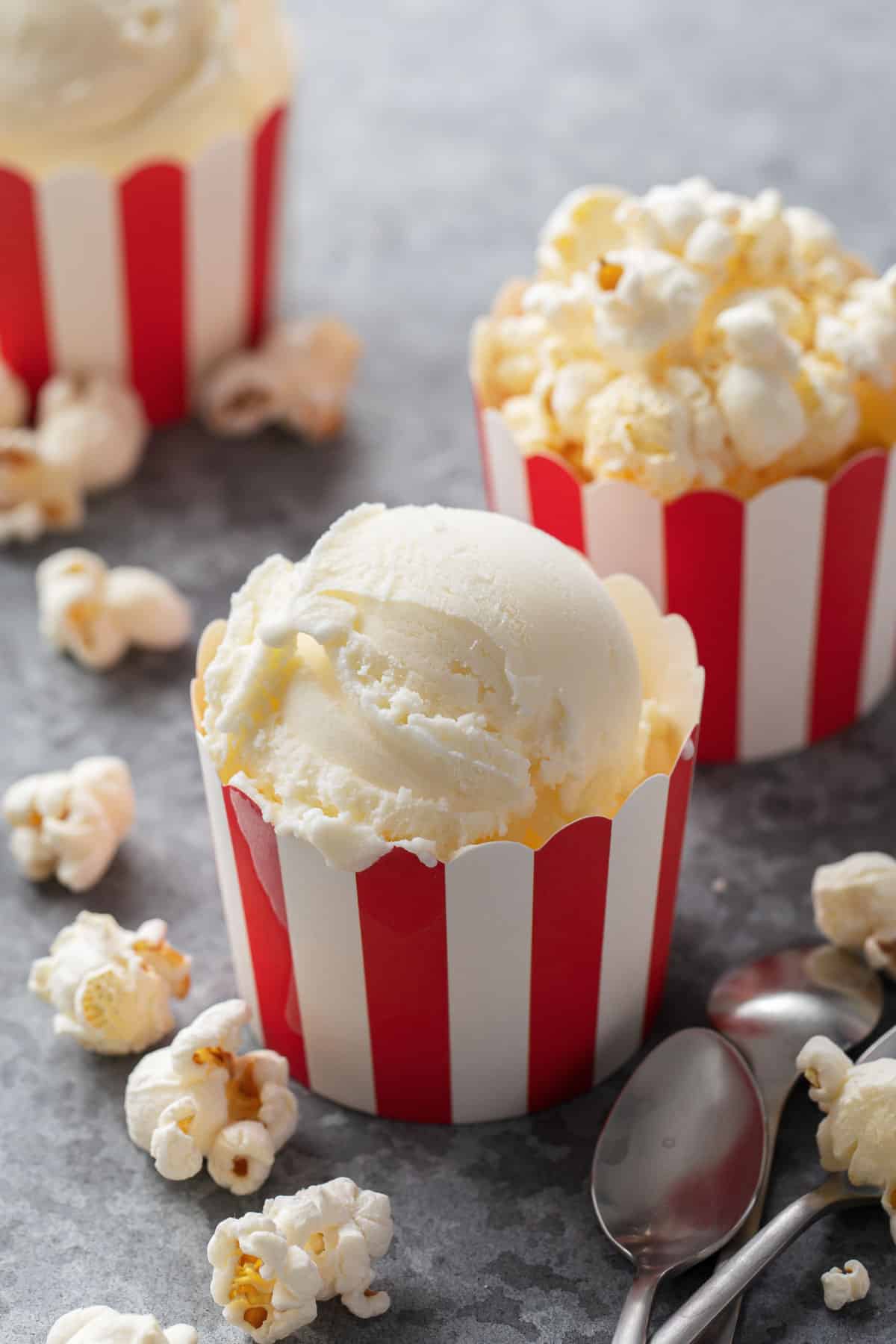

Please no ice, ice baby.
Unlike my bread-infused ice cream recipes, I opted for an eggless base for this one. Sometimes the egg in custard-based ice creams can make for a heavier flavor, and I feared it would overpower the delicate taste of the popcorn.
Without the egg in the custard base, however, you’re more at risk of ending up with an overly icy ice cream (which is funny that it’s called ice cream, since you definitely want more cream than ice in your ice cream).
The method to prevent large ice crystals in homemade ice creams is accomplished with three specialty ingredients: glucose syrup, dry milk powder, and a gum stabilizer.
Glucose syrup helps prevent large ice crystals from forming, much like it does in a cooked sugar recipe like caramel, where an invert sugar like glucose prevents the crystallization of the sugar (corn syrup or golden syrup being other invert syrups that work similarly). Glucose syrup also reduces the amount of sugar needed in the recipe without adding too much sweetness, and it reduces the freezing point of the mixture, making for a more scoopable ice cream that doesn’t melt as quickly.
Dry milk powder might seem redundant as the base is entirely milk and cream already, but it actually serves to add body and structure, and to help absorb excess water, which reduces ice crystals in the final product.
Finally, using a gum stabilizer to help better control the size of the ice crystals (again, smaller ice crystals make for a creamier ice cream that doesn’t melt as quickly). Gums also help increase the shelf-life of the ice cream (not that it will last very long, but still).
You may have noticed some eggless ice cream recipes that call for cream cheese? Those recipes are actually utilizing the stabilizers within the cream cheese more than the cream cheese itself. Since I didn’t want an obvious cream cheese flavor, I opted to just use the stabilizer on its own.
I used guar gum, but locust bean gum would work as well (the latter is often touted as the gold standard in ice creams, but I didn’t see much of a difference between it and guar gum, and guar gum is way cheaper). You can use either here, but I do not recommend leaving it out entirely.
I know these three ingredients require some extra effort to acquire, but they are very much worthwhile if you want smooth, creamy homemade ice cream. While you might be able to get away with omitting one of the three, I do not recommend skipping or substituting more than that, or you will end up with an overly icy ice cream with a less than desirable texture.
If you prefer custard-based ice creams made with egg yolks, you can follow my sourdough ice cream recipe here and just replace the bread with popcorn. I’ll often add a pinch of guar gum to custard-base ice creams as well, but it’s not required, and there is no glucose syrup or milk powder either.
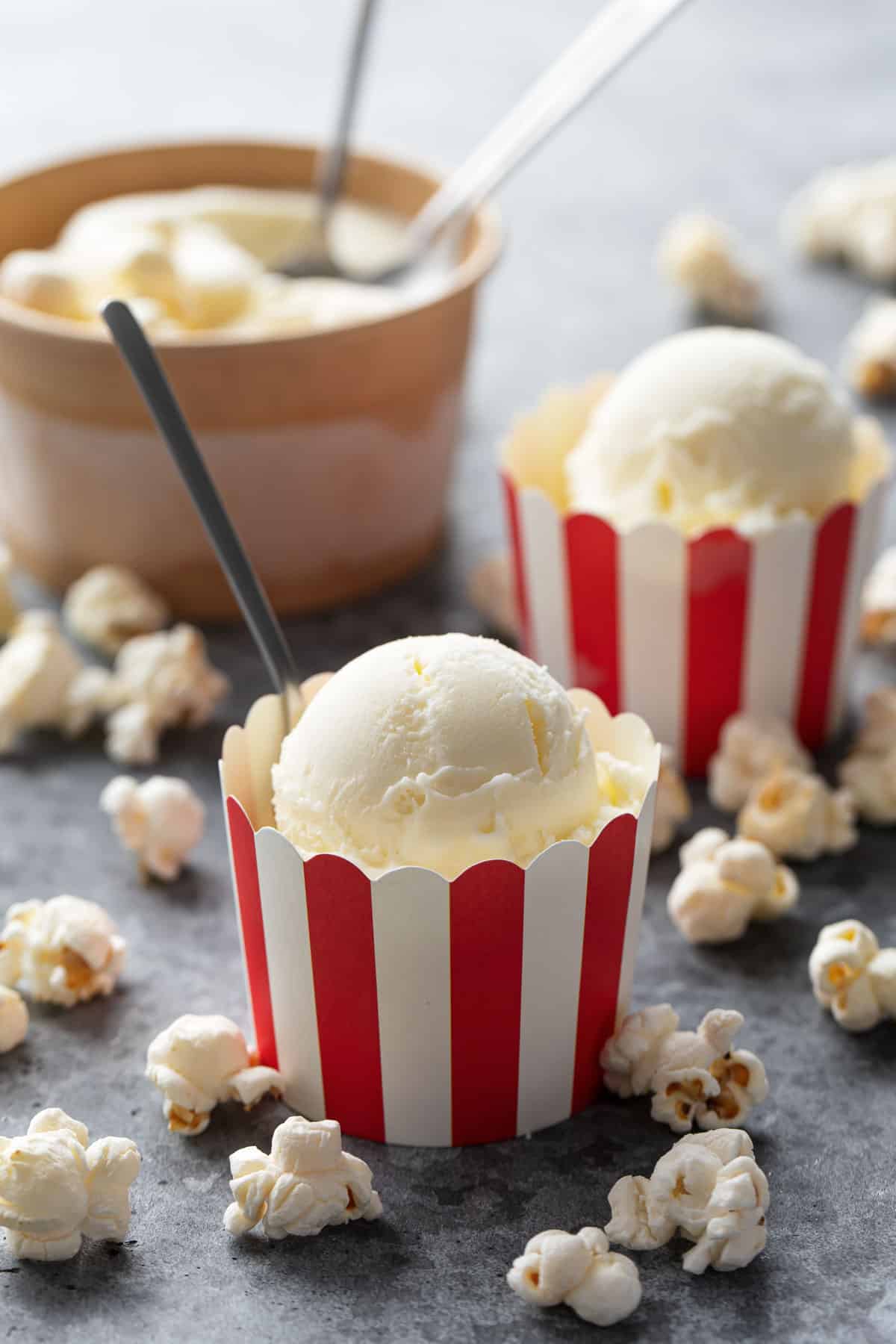

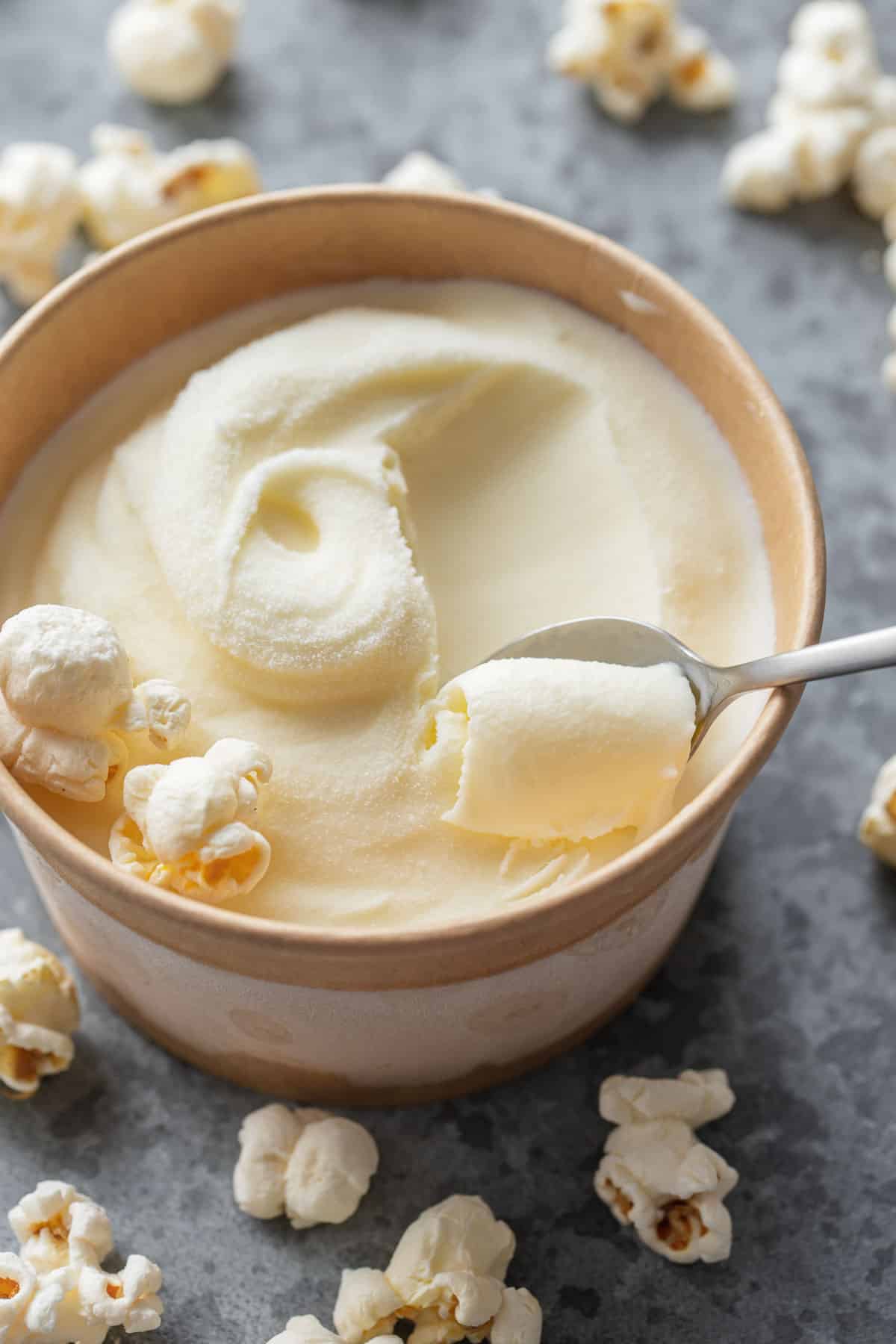

Here’s How to Make It
Even though this ice cream base is eggless, we do need to heat it up just a little bit, which allows the sugars to fully dissolve in the cream, and also gives us a warm cream base for infusing the popcorn flavor (the warm cream will absorb more flavor than cold cream would).
But no egg also means there is no finicky tempering or thickening involved. Just heat the cream until it’s good and steamy, but not fully boiling—that’s about 185 degrees F—then remove from heat and proceed as instructed.
After heating, the ice cream base needs to be completely chilled prior to churning. You can do this quickly in an ice bath, which I do anyway, but I also like to refrigerate it overnight just to be sure it’s good and cold (and also giving the popcorn flavor more time to infuse). The colder your ice cream base is when you start churning, the more quickly it will churn, and the smaller the ice crystals will be.
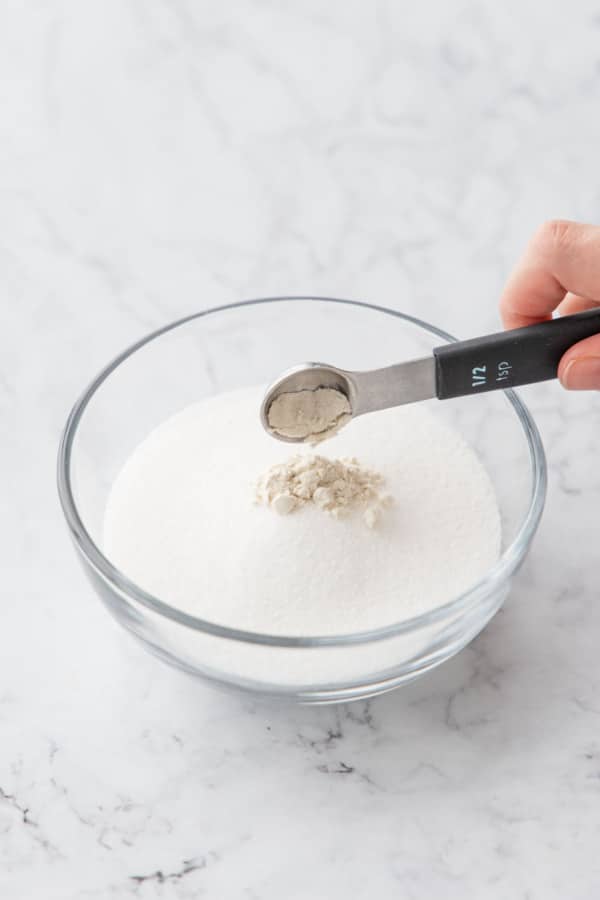

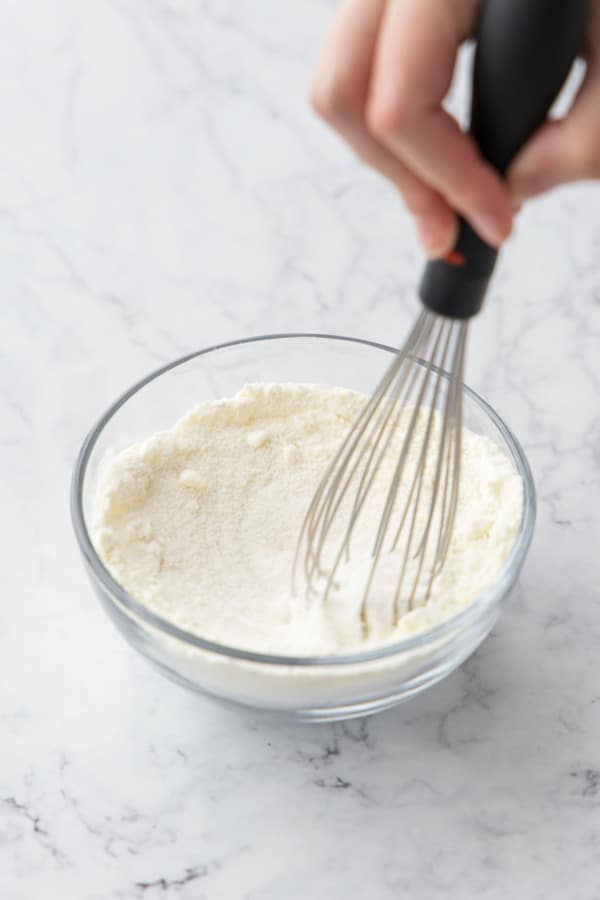

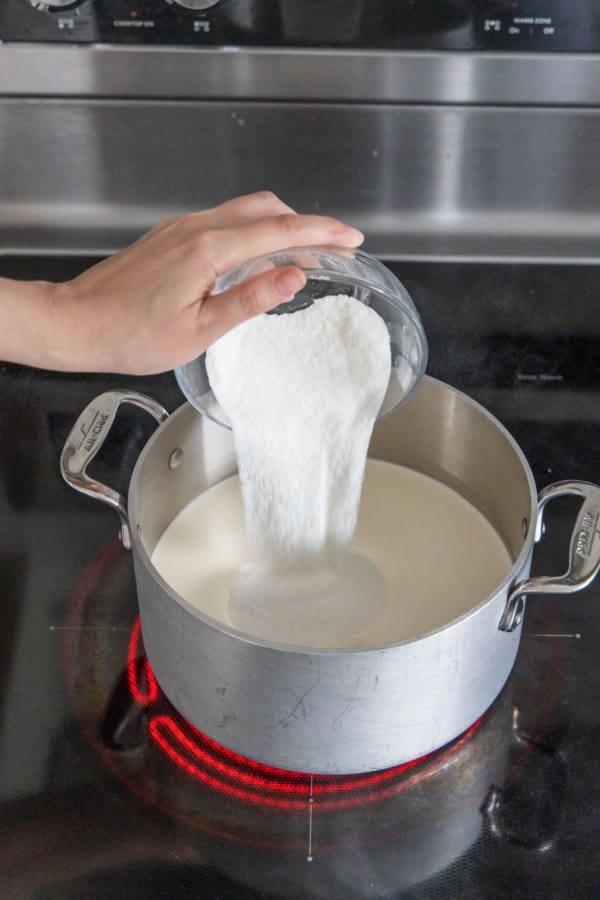

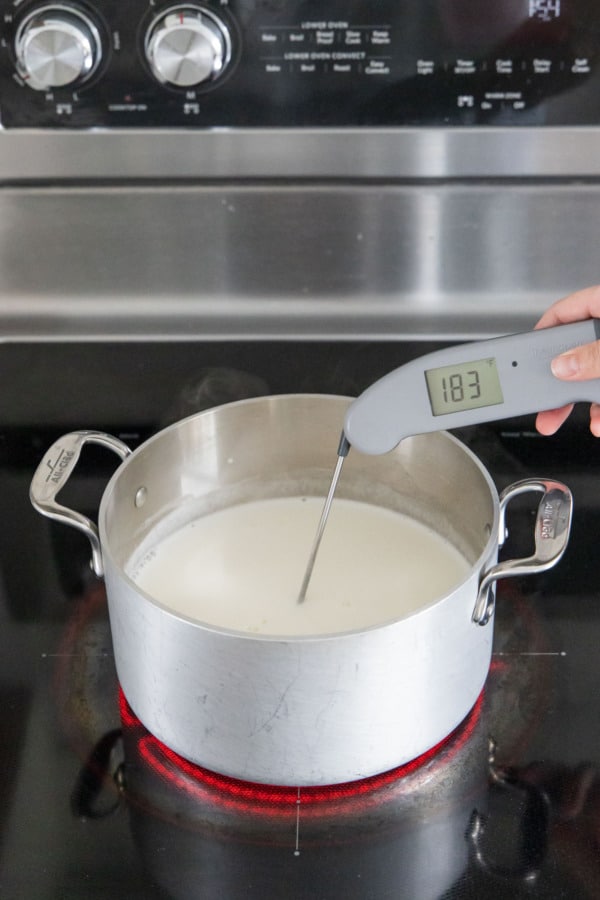

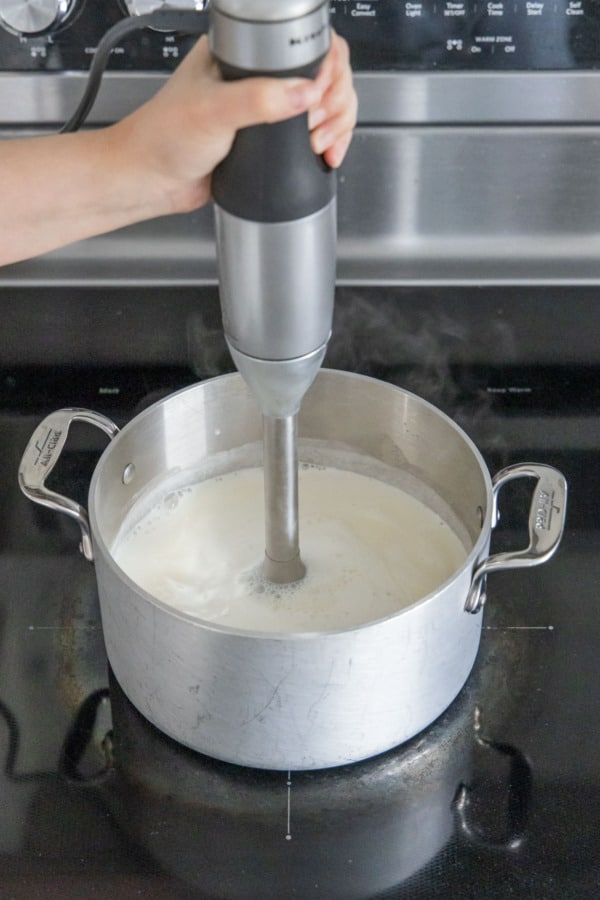

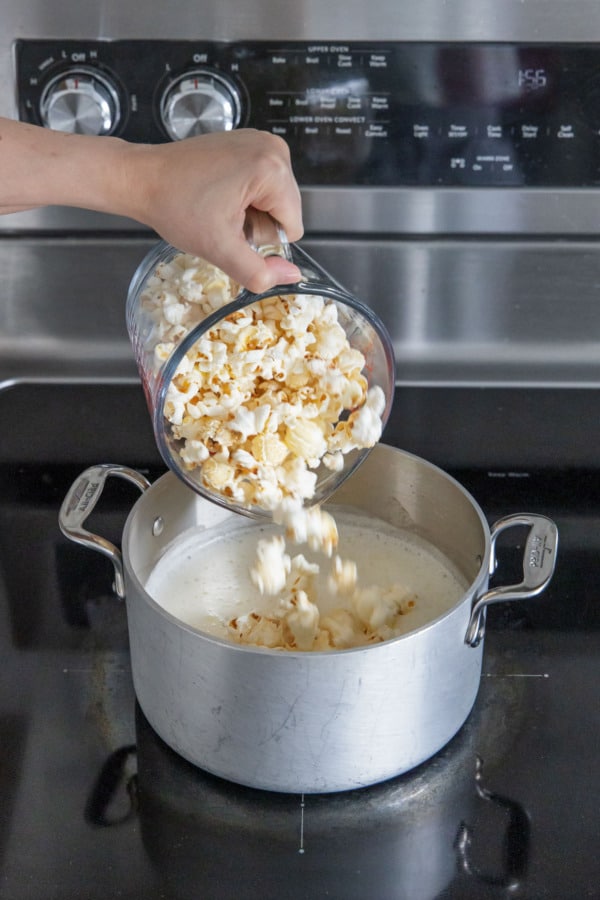

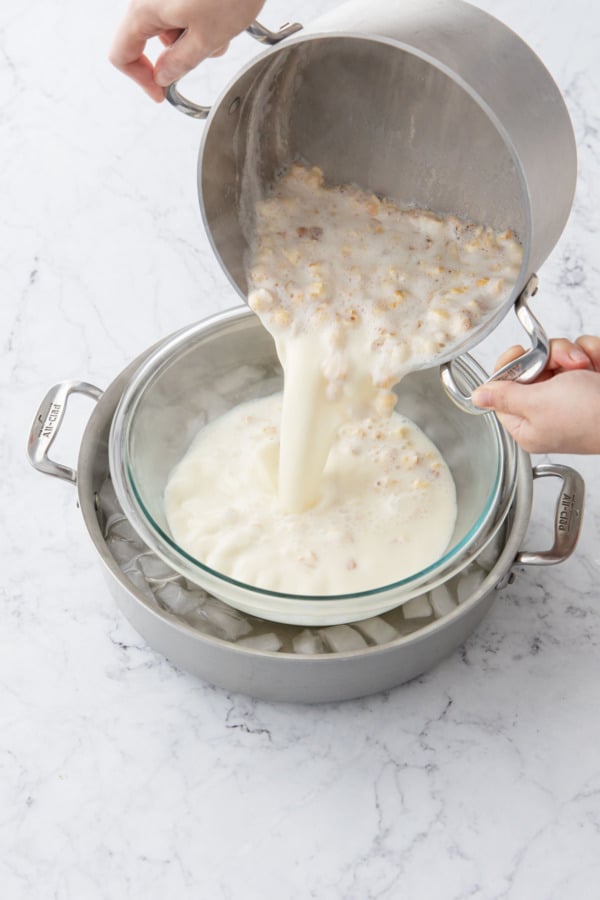

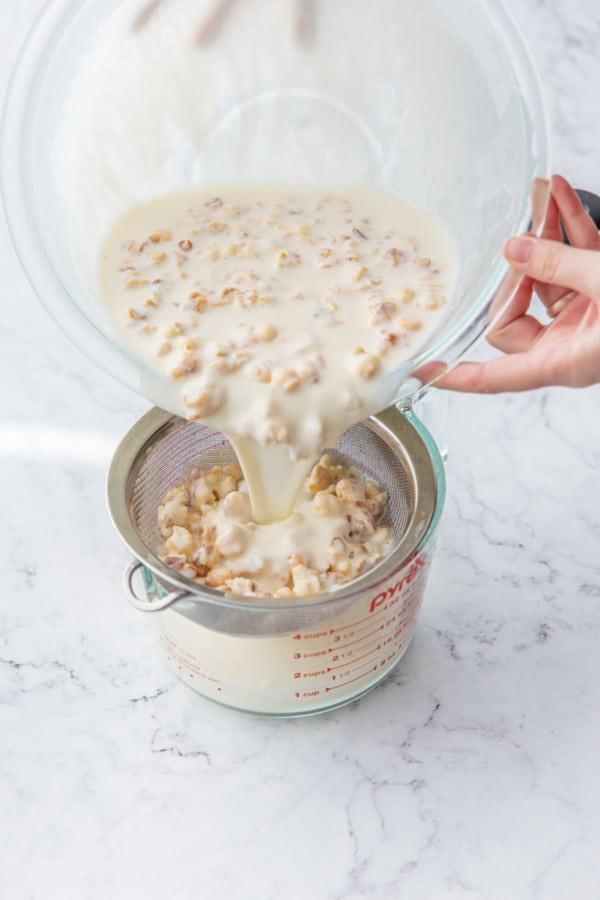

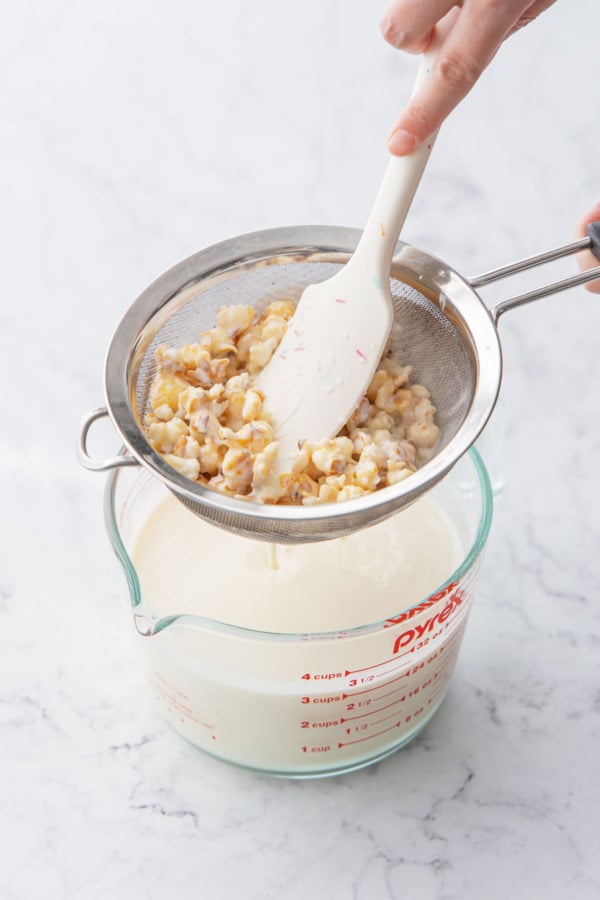

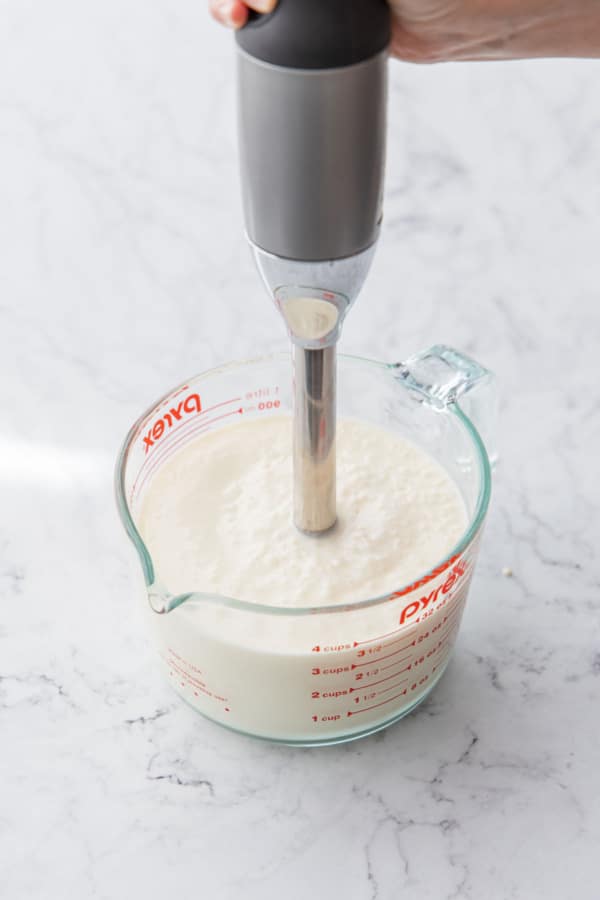

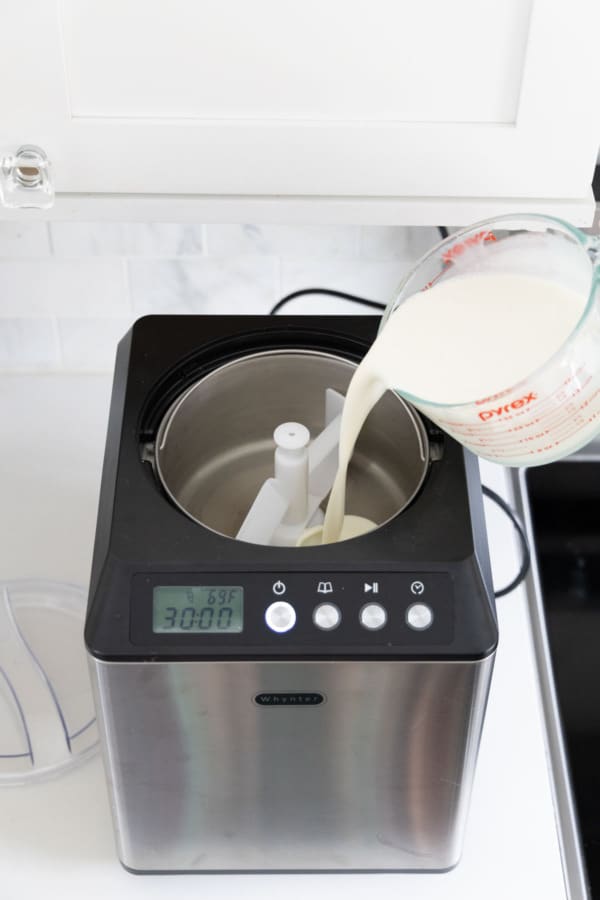

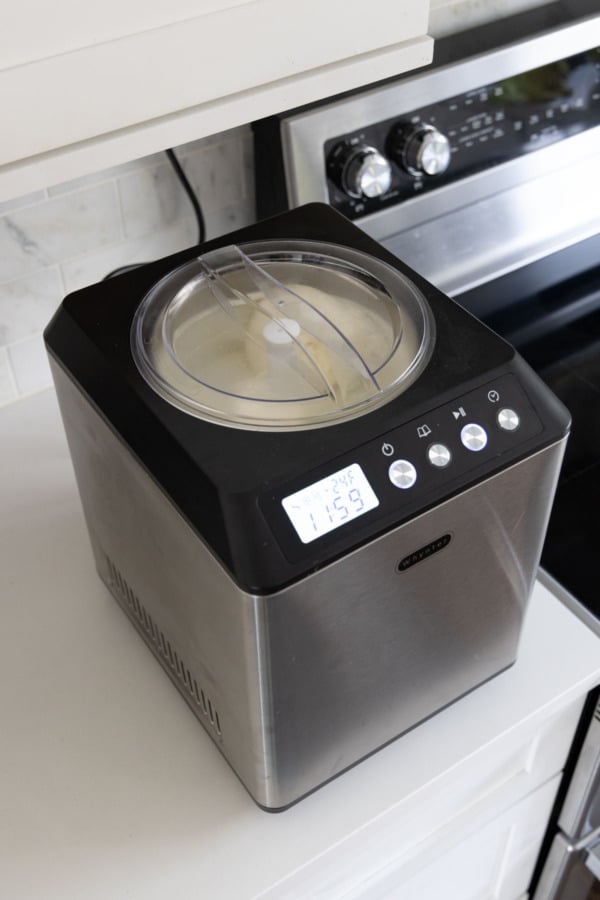

Why the blend?
You’ll notice this recipe calls for you to blend the cream mixture with an immersion blender twice during the process. This re-emulsifies the cream, which can easily separate when heated. And cream that has separated makes for a grainy, icy texture in the final churned ice cream, with a film of separated butter fat that coats your mouth in an undesirable way (you know what I’m talking about – that’s due to non-homogenized butterfat in the ice cream base).
You’ll likely see the separation I’m talking about if you refrigerate the ice cream base overnight; even with the stabilizers, there will likely be an obvious ‘cream top’ visible—these are the natural fats in the milk and cream that have separated and risen to the top. Again, because of our lack of egg here—egg, of course, serving as a natural emulsifier—this separation is much more obvious.
A thorough blending of the milk and cream mixture, both after the initial heating (before adding the popcorn), and again just before churning (after straining out the popcorn), will ensure that the ice cream base will churn up into a lusciously creamy, scoopable consistency. This step is particularly important if you’re using non-homogenized dairy to begin with.
If you don’t have an immersion blender, you can transfer the ice cream base to a regular blender and blend on low speed for a minute or so. It’ll work just as well, though an immersion blender is certainly easier with less cleanup.
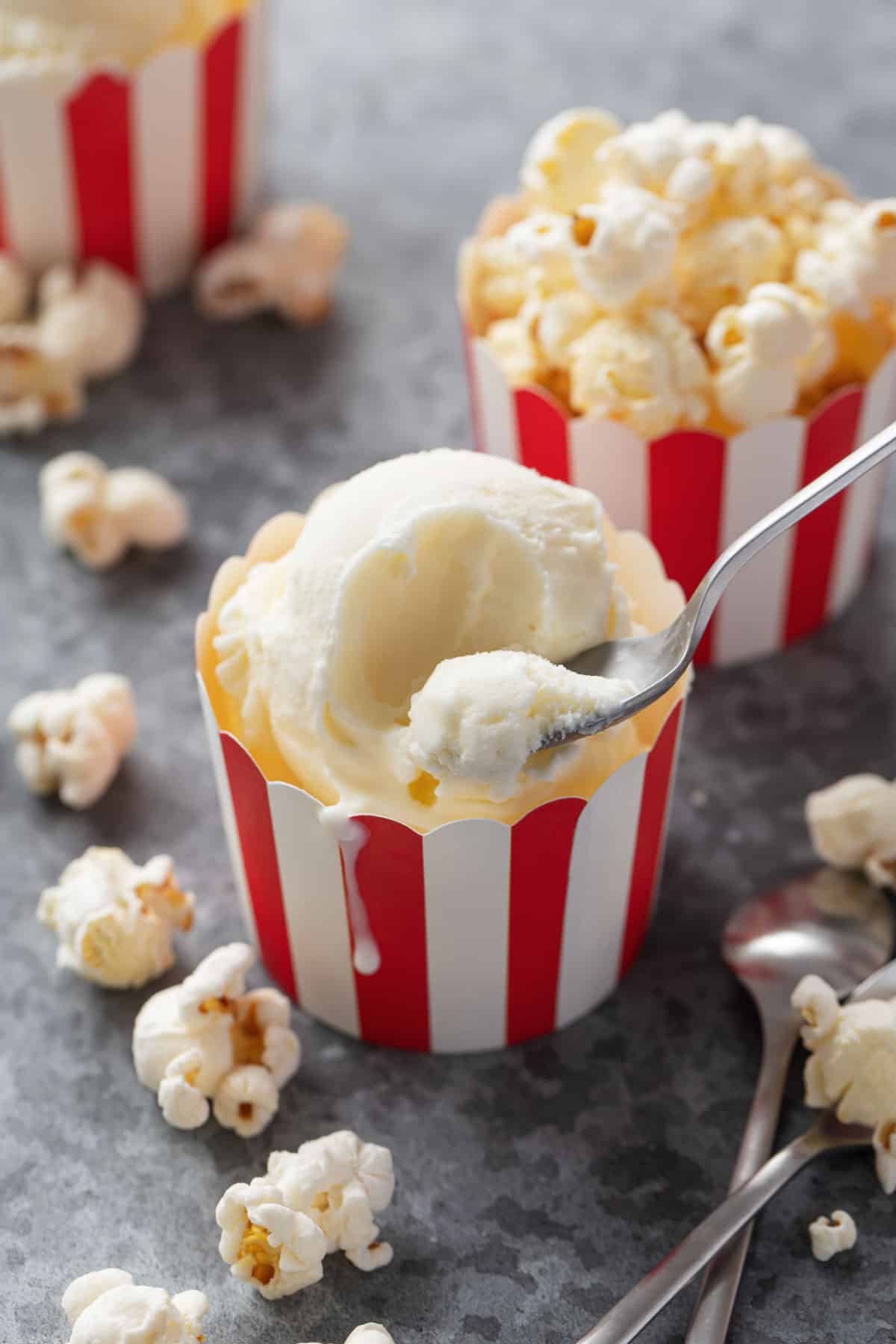

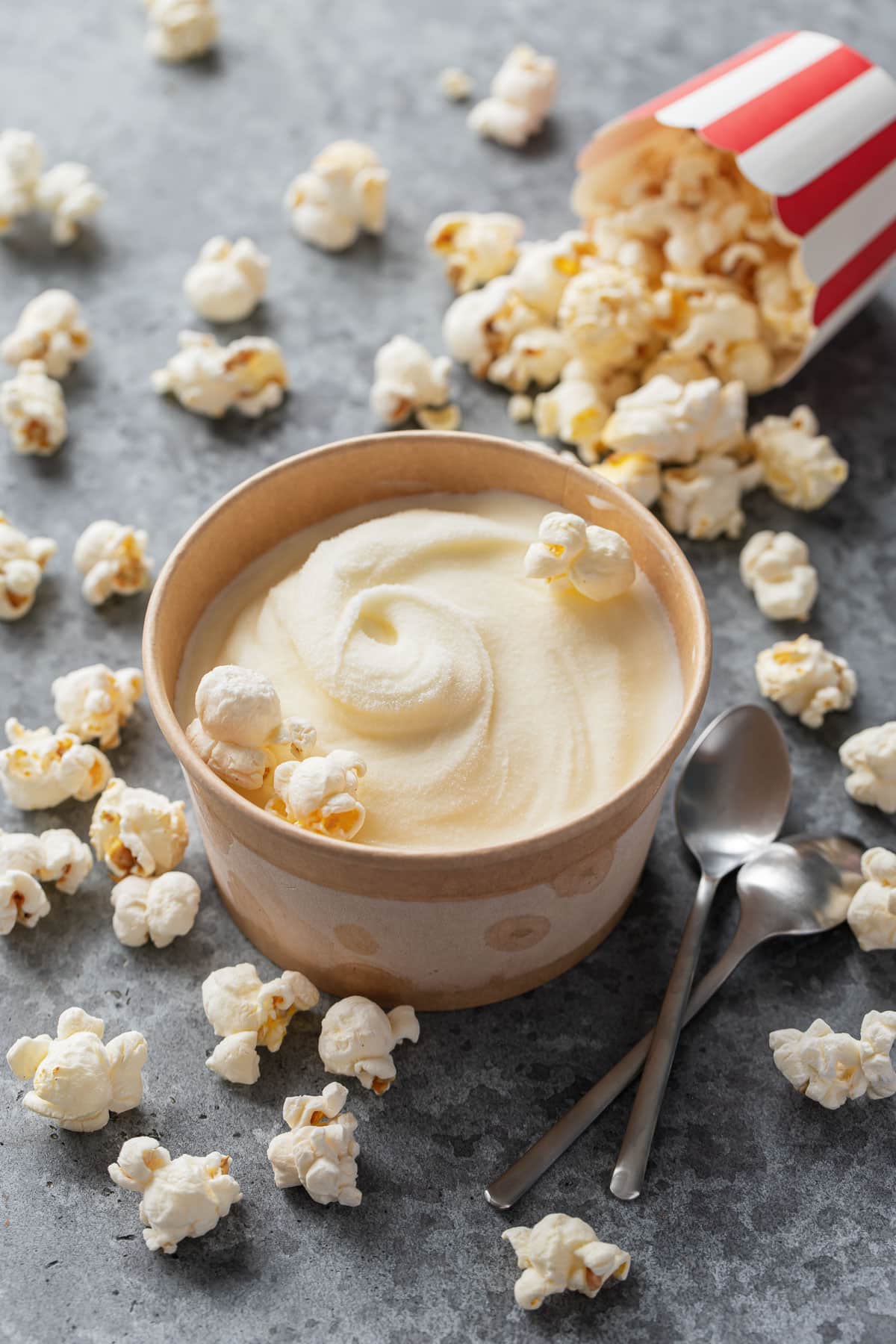

Ingredient Notes & Substitutions
Dry milk powder: I used whole milk powder, but skim or nonfat works fine too. It might seem redundant, adding dry milk to wet milk and cream, but the dry milk powder adds extra milkfat, providing extra body and structure to the churned ice cream, and helps absorb excess water as well (minimizing the icy texture).
Glucose syrup: again, our whole goal with homemade ice cream is to manage the size of the ice crystals, and glucose syrup does just that, much in the same way it’ll prevent a cooked sugar like caramel from crystalizing. I personally like pure glucose syrup, but light corn syrup or golden syrup works well too (the latter will affect the color/flavor just a bit). I think honey would be too strong a flavor here and I don’t recommend it.
Guar gum/locust bean gum: I know I sound like a broken record, but it’s all about controlled freezing and making the ice crystals as small as possible. And a gum stabilizer is probably the single best way to do that.
I made test batches of this recipe with both guar gum and locust bean gum; while the latter is often touted as the better option for ice creams, I didn’t notice much difference between them (though I did notice a huge difference in the batch made without a gum).
I’d highly recommend taking the time to ordering this ingredient ahead of time, as it will make a huge difference in the final product, especially considering this recipe is egg-free (eggs typically serve as an emulsifier and fat source that helps with ice crystal size in frozen custard recipes).
Popcorn: I’ve made this recipe with both home-popped corn (popped in an airpopper then topped with melted butter and sea salt), as well as a bag of TJ’s movie theater popcorn. Both worked, but we both agreed that the homemade popcorn had a better flavor. You can also use a bag of microwave popcorn, whatever you like best!
If you make your own popcorn, butter and season it how you like. We drizzled ours with a few tablespoons of melted salted European-style butter and a generous pinch of sea salt; you can also get popcorn butter powder which is the artificial butter flavoring used in microwave popcorn.
Buttered Popcorn Ice Cream
The flavor of freshly popped popcorn drizzled in melted butter… infused into homemade ice cream? Indeed, it might sound like weird magic but this stuff is legit delicious!
-
In a bowl, whisk dry milk powder and guar gum into sugar until evenly incorporated.
-
Combine milk and heavy cream in a saucepan. Add glucose syrup and sugar mixture warm over medium heat, stirring occasionally, until it starts to steam and barely bubble around the edges (do not let it fully boil). It should measure 185 degrees F on an instant-read thermometer.
-
Remove from heat and whir with an immersion blender for 1 minute, then add popcorn, stirring until popcorn is fully coated (it will shrink in volume as it starts to absorb moisture.
-
Place pan (or transfer to a bowl) in an ice bath until the cream base is cooled, 30 minutes or so, then cover and refrigerate at least 3 hours or overnight if possible.
-
Once fully chilled and just prior to churning, strain out popcorn with a fine mesh sieve, pressing firmly to get out as much liquid as possible.
-
Blend with an immersion blender one more time for 1 full minute (this will help re-homogenize the dairy that may have separated overnight).
-
Churn in an ice cream machine according to manufacturer’s instructions. When it is the consistency of soft serve, transfer to a freezer-safe container. Press a layer of parchment paper on the top of the container to prevent freezer burn, then cover and freeze at least 2 hours or overnight until firm.
- Guar gum or locust bean gum is a stabilizer that helps control the size of the ice crystals, which is especially needed because there are no eggs in this recipe. Leaving it out will result in an icier final product.
- You can use a bag of microwave popcorn here, or pop up your own from about 2 tablespoons of popcorn kernels. Coat with about 2 tablespoons of butter and a generous pinch of sea salt; you can also use a little bit of popcorn flavoring for a more authentic movie theater flavor.
All images and text © for Love & Olive Oil.
There may be affiliate links in this post. We are a participant in the Amazon Services LLC Associates Program, an affiliate advertising program designed to provide a means for us to earn fees by linking to Amazon.com and affiliated sites.
